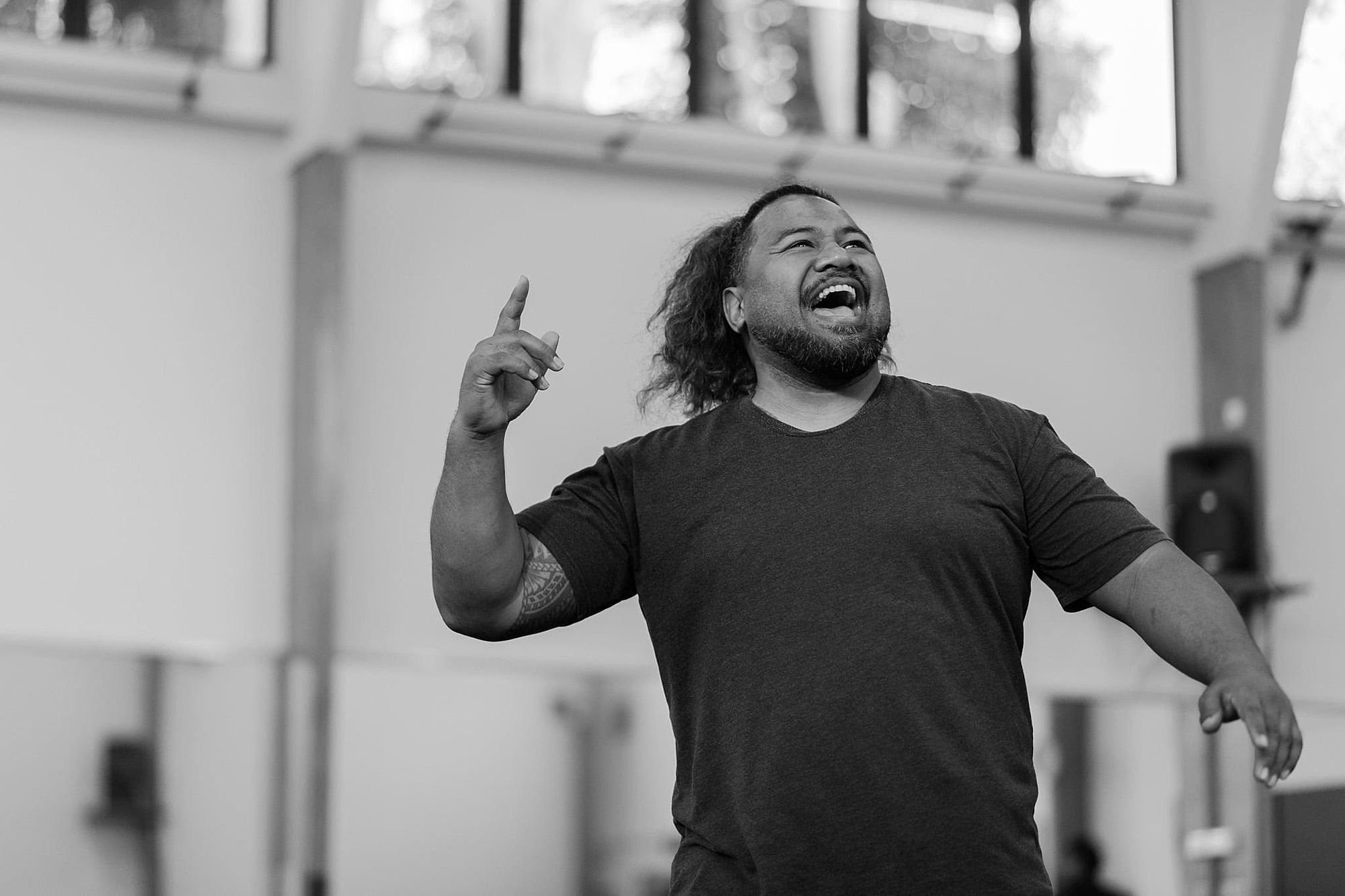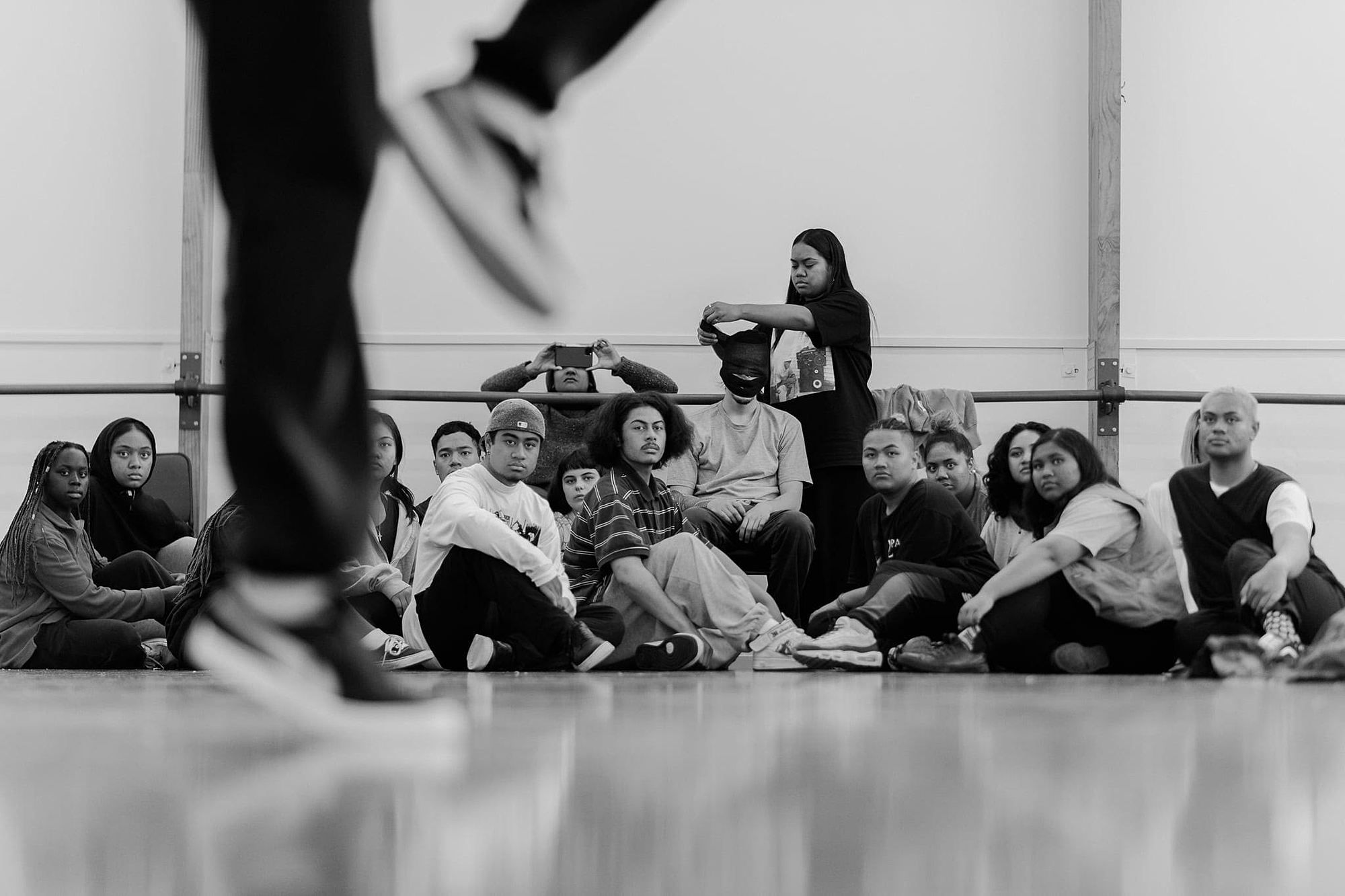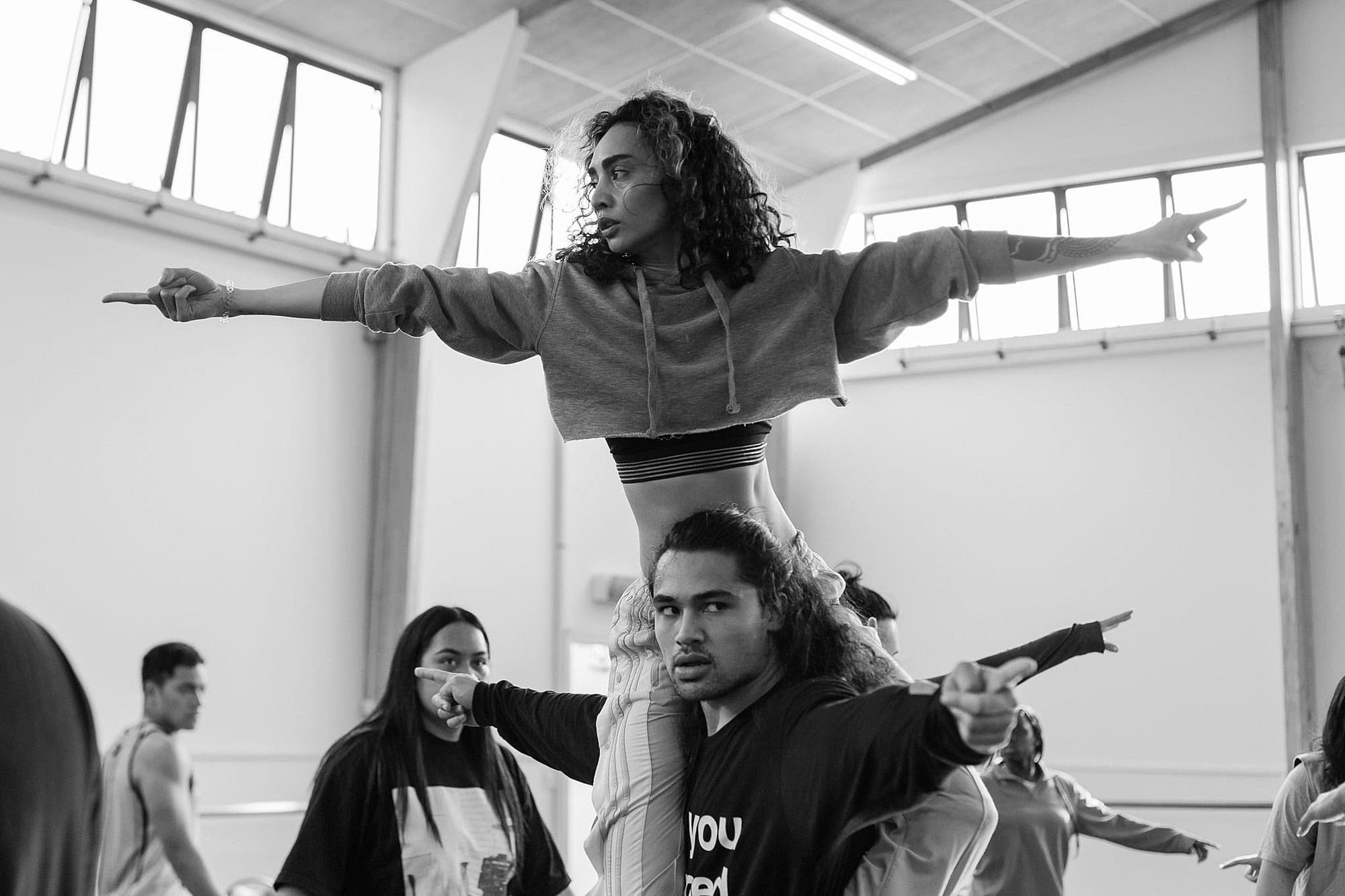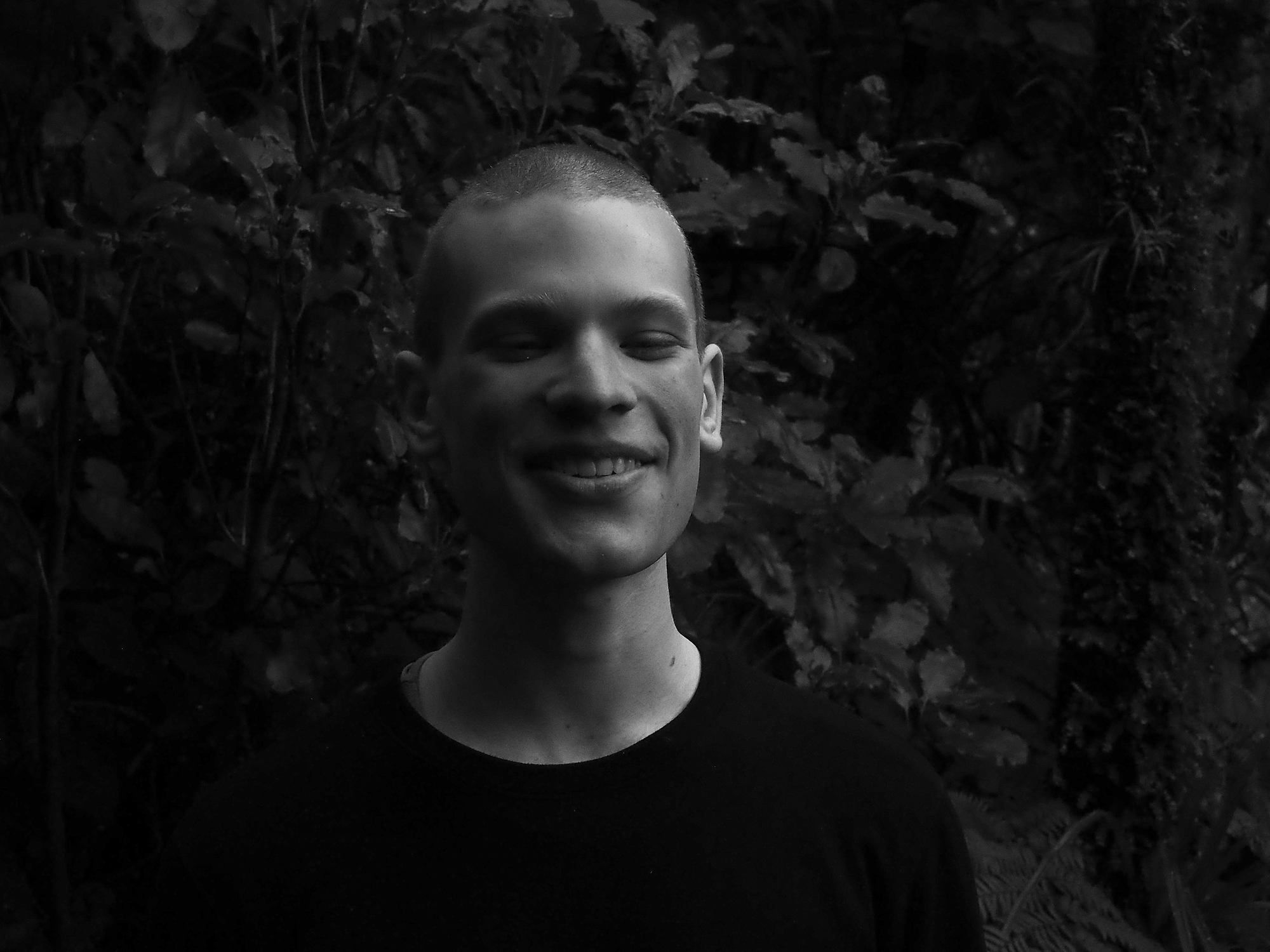All Our Cells, Singing
Amit Noy honours the artists of Ta‘alili’s performance Faces of Nature.
On 11 and 12 June in Tāmaki Makaurau, Ta‘alili performed Faces of Nature, their latest live offering. Directed by Aloalii Tapu and with set design by Tori Manley-Tapu, Faces of Nature was shared at Ngā Tohu o Uenuku in Māngere, as part of the 2021 Pacific Dance Festival. (Ta‘alili, the child of Tori Manley-Tapu and Aloalii Tapu, is the name of both their daughter and the organisation that houses their world-building art.) Many artists came together to make the work.
I saw Faces of Nature on the 11th. What follows is both an offering and a response, born of what remains of my unreliable memory.
- FALE, FALLING OR SPIRIT HOUSE FALLS AND GETS BACK UP
In the beginning, performer Joshua ‘Fale’ Faleatua sits cross-legged in the centre, eyes covered with tightly wound fabric. Fale waits until we are assembled and then unfurls with quiet crustacean grace. Unseeing, he begins a series of falls. Their limbs shyly crumple and grow back, meeting the ground with the ease of old friendship. Fale looks at home in the vā between the air and the floor, held in the sweet transit of having left but not yet arrived.
They know how much you gain when you give up verticality. They know the pleasure is in the rebuilding, the response-ability of getting back up. I enjoy unfastening my senses in the company of friends. Held by their care, I let go of the ropes that tie me upright.
2. FAITH OR SMILING IS (ALWAYS) AN AMBIVALENT ACT
With a smile that holds the promise of a bite, Faith Schuster sits in the power of the soil and caresses the air with her hands. Siva Sāmoa is her lodestar, but her performance oozes ambivalence. Like all of us, Faith arrives with both love and cynicism, but she knows enough not to give either one of them up. I feel enlivened by the shrewdness with which she wrangles cultural knowledge through her body, making the rich tapestry of siva tussle with the turgid artifice of Western ‘contemporary technique’.
Faith shows us that embodiment means being multiple, and that living brings about cross-contaminations between distinctions that were always already untrue. Our body cultures bicker and make love as they infect each other. They pay no heed to the colonial, racialised imperative to keep your dance pure.
These fugitive infections are gifts. Small miracles happen when we revel in our impurity, which is another word for fertility.
*
3. TAVAI OR HELICOPTER, HA!
Some lessons I have learnt from the actor Tavai Fa‘asavalu:
Make performance that confounds, and help us savour the tang of illegibility.
Virtuosity is at its richest when you don’t allow it to become any one thing.
Let the journey include meandering through (metaphorical) gas stations.
Translation is pandering: if we are unafraid of not-knowing, the vibration becomes enough.
Tell stories you care about, and let them wander in all directions.
LAUGH!
4. OOSHCON OR I LOVE YOU
With their feet standing proud in Krump, movement artist Ooshcon Masseurs unfolds whole ecologies of movement. I watch their hands build worlds with the rhythm and vivacity of light on water. The Enlightenment convinced us we were software systems, but Ooshcon reminds us we are compost – at our richest in our breakdowns and the way we break it down.
He mouths ‘I love you’ with a juicy thickness of everything, and I can feel my skin expand. Ooshcon’s body-love makes us porous, and opens us up to the pleasures of disintegration and regeneration.
*
5. EVERYONE
In the room, all at once, the Rewa Allstars flooding the space with their taut devotion. (Don’t trust the story I am telling, because I haven’t yet mentioned these young dancers from Manurewa High School, led by Mele Ta‘eiloa. They make Faces of Nature sing.)
Aloalii, artists and the Rewa Allstars dance with each other and us. Everyone together, navigating the pleasures and headaches of identity with fluid, generous grace.
I feel overwhelmed seeing so many cells sharing the drunk pleasure of kinesthesia.
6. JAHRA OR A GLITCHING TORRENT OF TINY CUTS
Speaking in her ancestral tongue, movement artist Jahra Wasasala wishes us happiness and good health. Except. The sound emerges in rhapsodic stutters, as a glitching torrent of tiny cuts.
Ni sa bula vinaka-a-a-a-a-a-a-a-
She knows language squeezes sensation into a thin paste of meaning, and restricts whole fields of experience with the structural violence of a sieve. And so Jahra cuts language, just as language cuts us. She catches the vowels in her throat and splinters them to spit out the shards like seeds.
She begins to fold with the smooth ease of hummus. Her pelvis collapses inwards with the seismic force of earthquakes, and she scuttles through space like a decapod on the ocean floor. Yes, this is dance – but it is more than that, too. In the physical activation of her selfhood, Jahra invokes the more-than-human embodiments of the subterranean moana.
When she finishes, the Allstars enter to resettle what has been agitated. They beat the floor with tree branches, restoring the neutrality of the space. Some leaves stay resting on the floor.
*
7. ALOALII OR CATFISHING OMNISCIENCE
What was once solid becomes two doors, as a wall’s steel force yields to reveal Aloalii and a gentle parachute. He is crawling with great care, and dragging a small crater the colour of an exhalation. Aloalii’s friend, the parachute, is part spacecraft, part survival tool and part amoeba. It pulsates with the tender, protracted rhythm of a jellyfish.
The Allstars enter brusquely and carry him away. His sudden absence deflates the burgeoning image of a lone hero. It is the dramaturgical equivalent of the cheeky bunny fingers in a photo op – a chuckling destabilisation of authority played by the (co)author himself. What is the point of a climax when it is so much more satisfying to bunny-ear your own show? Once Aloalii departs, the empty promise of heroics goes off like sour milk, and we are left to savour the catfishing of omniscience.
8. TAVAI AND THE WATER BALLOONS
Three rocks, a parachute and a suit made by Tori Manley-Tapu were the rich bed of soil on which Faces of Nature proudly stood.
At the end, Tavai Fa‘asavalu stands among the rocks and the abandoned parachute, wearing the delicate white suit. One by one, the Allstars approach, holding a balloon in their left hand and a needle in their right. Each balloon is held over Tavai, and for each, the needle fails at first. Their tepid exasperation is the funniest, most joyful thing I see all month.
Eventually, a flaccid cackle of water escapes over Tavai. After the popping, each Allstar leaves as they are – some depart with hunched shoulders and others strut, serving face on a backward glance.
As the water sighs out, the paper suit begins to melt, until only small scraps of wet paper coat his skin. Tavai begins to dance, in gentle communion with the stories the others have left. They practice body empathy beautifully, like no other: empathy with the water rivulets, empathy with the vibrations of the music, and empathy with the unseen elephants of the no-longer and the not-yet.
Faces of Nature honours the ecstasy of liveness. My gratitude to all the artists, for is there anything better than the particular chemical miracle of moving and being moved?
Photographer: Jinki Cambronero




